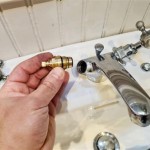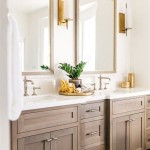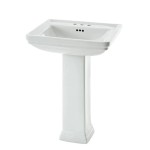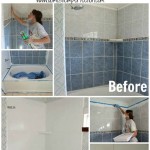How to Keep Your Bathroom Vanity Clean
The bathroom vanity serves as a central hub in the bathroom, providing storage, countertop space, and a focal point for the overall design. However, its prominent location and frequent use also make it a magnet for clutter, spills, and grime. Maintaining a clean and organized vanity contributes not only to the aesthetics of the bathroom but also to hygiene and overall functionality. A systematic approach to cleaning and regular maintenance is essential for keeping the vanity in optimal condition.
Effective cleaning of the bathroom vanity requires understanding the different materials typically used in its construction, from the countertop surface to the cabinet materials. Different materials necessitate different cleaning approaches and products to avoid damage or discoloration. A consistent cleaning routine, coupled with proper storage solutions, ensures the vanity remains a clean and functional space within the bathroom.
Understanding Your Vanity Materials
The first step to properly cleaning a bathroom vanity involves identifying the materials it comprises. Countertops are commonly made from materials such as marble, granite, quartz, laminate, or solid surface materials. Each material possesses different properties and sensitivities to cleaning agents.
Marble, for instance, is a porous natural stone and is highly susceptible to staining and etching from acidic substances. Granite, while more durable than marble, still requires pH-neutral cleaners to prevent damage to its sealant. Quartz, a manufactured stone, is generally non-porous and more resistant to staining, but abrasive cleaners should still be avoided. Laminate countertops are more affordable but can be easily damaged by excessive moisture and harsh chemicals. Solid surface materials, like Corian, are durable and non-porous but may require specific cleaning products recommended by the manufacturer.
Vanity cabinets are often constructed from wood, plywood, MDF (Medium-Density Fiberboard), or particleboard, often with a laminate or painted finish. Solid wood provides a durable and aesthetically pleasing option but can be prone to moisture damage and warping if not properly sealed and maintained. Plywood offers better moisture resistance than solid wood but can still be affected by prolonged exposure to water. MDF and particleboard are less expensive but are highly susceptible to water damage and should be kept dry.
Knowing these material characteristics is crucial for selecting appropriate cleaning products and techniques, safeguarding the longevity and appearance of the vanity.
Establishing a Regular Cleaning Routine
A consistent cleaning schedule significantly reduces the amount of time and effort required to maintain a clean bathroom vanity. The frequency of cleaning depends on factors such as usage, the number of people using the bathroom, and lifestyle habits. However, a general guideline is to incorporate both daily and weekly cleaning tasks.
Daily cleaning should consist of wiping down the countertop surface after each use to remove water splashes, toothpaste residue, and other spills. A microfiber cloth dampened with warm water is often sufficient for this purpose. For more stubborn residue, a mild, pH-neutral cleaner can be used, but it is important to avoid abrasive cleaners that can scratch the surface.
Weekly cleaning should involve a more thorough cleaning of the entire vanity. This includes cleaning the countertop with an appropriate cleaner based on the material, wiping down the cabinet doors and drawers, and cleaning the sink and faucet. Consider using a cleaner specifically formulated for bathroom surfaces to effectively remove soap scum, hard water stains, and mildew. Pay attention to crevices and corners, where dirt and grime tend to accumulate.
Periodically, usually monthly or quarterly, a deeper clean should be performed. This involves emptying the vanity cabinets and drawers, wiping them out with a damp cloth and a mild cleaning solution, and decluttering the contents. This is also a good time to inspect for any signs of water damage or mold growth.
Integrating these cleaning tasks into a regular routine prevents the buildup of dirt and grime, making the cleaning process less time-consuming and maintaining the appearance of the vanity.
Effective Cleaning Techniques and Products
The specific cleaning techniques and products used will vary depending on the vanity's materials. However, some general principles apply to all types of bathroom vanities.
Always start by removing any loose items from the countertop, such as toiletries, makeup, and decorative items. This allows for unobstructed access to the entire surface.
For countertops, select a cleaner specifically designed for the material. For marble and granite, use a pH-neutral cleaner to avoid etching. For quartz and solid surface materials, a mild all-purpose cleaner can be used. For laminate countertops, avoid excessive moisture and strong chemicals. Spray the cleaner onto a microfiber cloth rather than directly onto the countertop to prevent oversaturation and potential damage.
When cleaning cabinet doors and drawers, use a damp cloth with a mild detergent to remove dirt and grime. Avoid using abrasive scrubbers or harsh chemicals, as these can damage the finish. Pay particular attention to areas around the handles and knobs, where fingerprints and dirt tend to accumulate. For wooden cabinets, use a wood cleaner or polish to maintain their luster.
The sink and faucet often accumulate soap scum and hard water stains. Use a bathroom cleaner specifically formulated to remove these types of stains. For stubborn stains, a paste made from baking soda and water can be applied and left to sit for a few minutes before scrubbing gently with a soft brush or sponge.
After cleaning, thoroughly rinse all surfaces with clean water and dry them with a clean, dry cloth. This prevents water spots and streaks from forming. For wooden cabinets, ensure they are completely dry to prevent water damage.
Preventative Measures and Maintenance
Beyond regular cleaning, several preventative measures can be taken to minimize dirt and grime accumulation and prolong the life of the bathroom vanity. These measures focus on minimizing spills, controlling moisture, and maintaining proper ventilation.
Using trays or organizers for toiletries and makeup on the countertop can help contain spills and prevent them from spreading. These organizers also help to keep the countertop clutter-free, making it easier to clean.
Placing mats or small rugs under the sink area can absorb water splashes and prevent them from damaging the cabinet base. These mats should be regularly cleaned and replaced as needed.
Ensuring proper ventilation in the bathroom is crucial for preventing moisture buildup and mold growth. Use the exhaust fan during and after showers to remove excess moisture from the air. If the bathroom does not have an exhaust fan, consider opening a window to improve ventilation.
Periodically inspect the vanity for any signs of water damage, such as swelling, discoloration, or peeling. Address any leaks or water damage promptly to prevent further deterioration. Apply sealant to any exposed edges or seams to protect them from moisture.
Avoid placing hot styling tools directly on the countertop, as this can damage the surface. Use heat-resistant mats or holders to protect the vanity from heat damage.
Regular maintenance, such as tightening loose screws and hinges on cabinet doors and drawers, can help to extend the life of the vanity. Also, consider applying a sealant to the countertop periodically to protect it from stains and water damage.
Organizing for Cleanliness
A cluttered vanity is more difficult to clean and maintain. Implementing organizational strategies can significantly reduce clutter and simplify the cleaning process.
Start by decluttering the vanity contents, removing any items that are expired, no longer used, or duplicates. Sort remaining items into categories, such as skincare, makeup, hair care, and toiletries.
Utilize storage containers, such as drawer dividers, baskets, and organizers, to keep items neatly separated and easily accessible. Clear containers allow for easy visibility of contents.
Consider using vertical storage solutions, such as shelves or tiered organizers, to maximize space and keep items off the countertop. Wall-mounted storage options can also free up valuable countertop space.
Keep frequently used items within easy reach and store less frequently used items in less accessible locations. This streamlines the daily routine and prevents unnecessary clutter.
Label storage containers to easily identify their contents. This is particularly helpful for shared bathrooms or households with multiple users.
Regularly assess and declutter the vanity contents to prevent the accumulation of unnecessary items. A decluttered vanity is easier to clean, more functional, and more aesthetically pleasing.
Addressing Specific Stains and Problems
Despite regular cleaning efforts, specific stains or problems may arise on the bathroom vanity. Addressing these promptly and effectively is essential to prevent permanent damage.
Hard water stains can be removed with a solution of vinegar and water. Apply the solution to the affected area and let it sit for a few minutes before scrubbing gently with a soft brush or sponge. Rinse thoroughly with clean water and dry.
Soap scum can be removed with a bathroom cleaner specifically formulated to dissolve soap scum. For stubborn soap scum, a paste made from baking soda and water can be applied and left to sit for a few minutes before scrubbing gently.
Mold and mildew can grow in areas with high moisture. Use a mold and mildew cleaner to kill the growth and prevent it from returning. Ensure proper ventilation in the bathroom to minimize moisture buildup.
Ink stains can be removed with rubbing alcohol or a specialized stain remover. Test the cleaner in an inconspicuous area first to ensure it does not damage the surface.
Grease stains can be removed with a degreasing cleaner or a solution of dish soap and water. Apply the cleaner to the affected area and let it sit for a few minutes before wiping clean.
For stains that are difficult to remove, consult with a professional cleaning service or a countertop manufacturer for recommendations on appropriate cleaning solutions and techniques.

5 Easy Ways To Declutter Your Bathroom Countertop

How To Keep Your Bathroom Clean In 5 Minutes A Day

How To Design A Bathroom That S Easy Clean

Declutter The Bathroom 20 Items To Get Rid Of Now Clean And Scentsible

Organize The Space Under Bathroom Sink Life Creatively Organized

How To Keep Your Bathroom Clean In 5 Minutes A Day

Bathroom Counter Organizer Ideas And Methods The Family Handyman

How To Design A Bathroom That S Easy Clean

How To Keep Your Bathroom Countertop Clean And Organized Mc Granite Countertops

Bathroom Vanity Storage And Organization Ideas You Need
Related Posts







